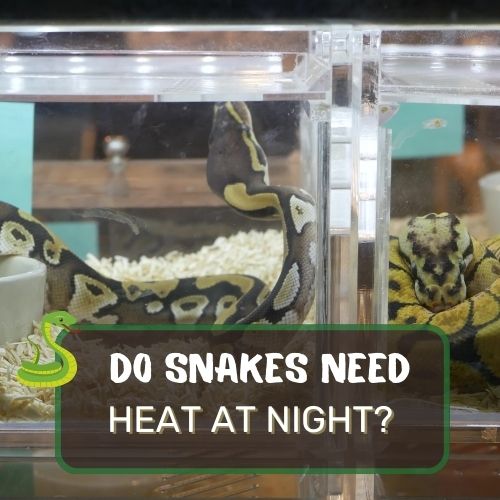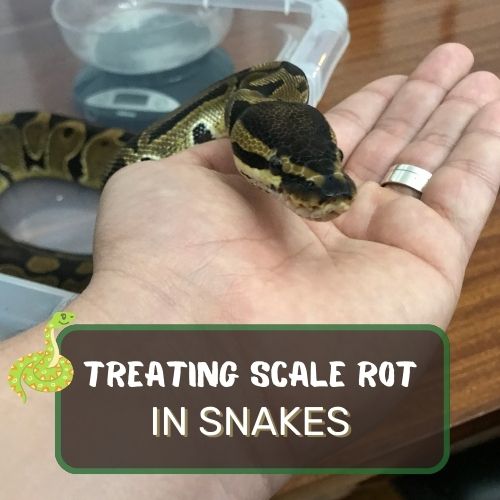
Are you curious about the intriguing world of snakes and their nighttime habits? If so, you might be wondering, “Do snakes need heat at night?”
In this comprehensive article, we will explore this fascinating topic and delve into the factors that influence the heating needs of these enigmatic reptiles during the nighttime hours.
By reading this article, you will gain insights into expert opinions, differences between diurnal and nocturnal species, the benefits of nighttime heating, alternative heating options, temperature guidelines, common myths, real-life experiences, and essential considerations for snake owners.
Whether you’re a seasoned snake enthusiast or a curious newcomer, this article promises to provide valuable information about the heating requirements of snakes during the night.
Table of Contents
- 1 Do snakes need heat at night? (Short Answer)
- 2 Heat requirement for snakes at night (Ultimate Guide)
- 3 Snake Heating Basics
- 4 Benefits of Heat at Night for Snakes
- 5 Alternatives to Heat Lamps at Night
- 6 Temperature Guidelines for Snakes at Night
- 7 Common Myths and Misconceptions
- 8 Considerations for Snake Owners
- 9 FAQ
- 10 Conclusion
Do snakes need heat at night? (Short Answer)
Yes, snakes do need heat at night. As ectothermic creatures, they rely on external heat sources to regulate their body temperature and carry out essential physiological functions. While some snake species are active during the night, others may reduce their activity levels, but they still require proper heating to maintain their health and well-being.
Providing the right nighttime heating is crucial for snakes, as it ensures their metabolism functions efficiently, aids in digestion, and promotes overall activity.
The specific temperature requirements may vary based on the species, but a general range of 70°F to 80°F (21°C to 27°C) for nocturnal snakes and 65°F to 75°F (18°C to 24°C) for diurnal snakes is commonly recommended.
Heat requirement for snakes at night (Ultimate Guide)

Why Snakes Require Heat At Night
Heat plays a pivotal role in the physiology and behavior of snakes. As ectotherms, snakes rely on external sources of heat to regulate their body temperature. Here’s a deeper exploration of their heat requirements:
- Digestion: After consuming a meal, snakes require warmth to efficiently digest their food. Heat accelerates metabolic processes, ensuring that nutrients are effectively absorbed and waste is expelled.
- Activity and Behavior: A snake’s activity level is closely tied to its body temperature. In cooler conditions, snakes become lethargic and less responsive. Conversely, in optimal heat ranges, they are more active, hunting, exploring, and mating.
- Reproduction: Heat influences the reproductive cycles of snakes. Mating, egg incubation, and the birthing process of live-bearing species are all temperature-dependent.
- Shedding: Proper heat levels aid in the shedding process. Adequate warmth ensures that the old skin detaches uniformly, preventing issues like retained eyecaps.
- Immune Function: Optimal temperatures bolster a snake’s immune system, helping fend off infections and diseases.
- Thermoregulation: Snakes don’t maintain a constant body temperature. Instead, they thermoregulate by moving between warmer and cooler areas. In captivity, providing a temperature gradient, with a designated basking spot and cooler retreat, allows snakes to self-regulate their temperature.
- Captive Care: For snake keepers, understanding species-specific heat requirements is crucial. Underheating can lead to digestive issues and lowered immunity, while overheating can be fatal.
Differences Between Diurnal and Nocturnal Snake Species
One aspect that plays a significant role in determining whether snakes need heat at night is their activity pattern.
Snake species can be broadly categorized into diurnal and nocturnal groups. Diurnal snakes are primarily active during the day, while nocturnal snakes come to life during the cover of darkness.
For diurnal snakes, maintaining an optimal body temperature throughout the day is crucial. They bask in the sun to absorb heat and carry on their daily activities.
In contrast, nocturnal snakes often operate in cooler environments, and their bodies might be adapted to handle lower temperatures more effectively.
Snake Heating Basics

Regardless of whether snakes need heat at night or not, one thing is undeniable: heat plays a vital role in their lives.
As ectothermic creatures, they rely on external heat sources to regulate their body temperature, which, in turn, affects their metabolism, digestion, and overall activity levels.
Natural Heating Patterns in the Wild
In their natural habitats, snakes have developed various ways to find and utilize heat. They may sunbathe on rocks, sandy surfaces, or branches to raise their body temperature, enabling them to be more active and agile in their pursuit of prey.
It’s intriguing to observe how snakes’ behavior changes with the seasons, reflecting their need for heat.
During the colder months, some snakes enter a state of hibernation, where they become less active and conserve energy by lowering their body temperature.
In contrast, during warmer months, they become more active, often displaying their thermoregulatory behaviors more visibly.
Factors to Consider When Providing Heat for Pet Snakes
For those who keep snakes as pets, understanding their heating requirements is crucial for their well-being.
Creating a suitable habitat that mimics their natural environment is essential. This includes providing a temperature gradient within their enclosure, allowing them to choose between warmer and cooler areas as needed.
Using heat lamps, heating pads, or ceramic heaters can help maintain the appropriate temperature for pet snakes. It’s essential to monitor the temperature regularly and ensure it falls within the species-specific recommended range.
Benefits of Heat at Night for Snakes

Role of Heat in Maintaining Metabolic Functions
Heat is not just a luxury but a necessity for snakes, especially during the nighttime. As ectothermic creatures, snakes rely on external heat sources to regulate their body temperature and carry out essential metabolic functions.
During the cooler nighttime hours, providing heat ensures that their bodies remain within the optimal temperature range, which is vital for digestion, enzyme activity, and overall metabolic processes.
Proper heating at night helps snakes maintain their physiological functions at an optimal level, ensuring they stay healthy and active, even during periods of reduced activity.
Benefits of Providing a Thermal Gradient for Snakes
In both natural and captive environments, creating a thermal gradient is crucial for snakes. A thermal gradient refers to a range of temperatures within their habitat, allowing them to move between warmer and cooler areas as needed.
At night, a well-maintained thermal gradient enables snakes to make informed choices about their temperature preferences.
This freedom to move between warm and cooler spots ensures they can regulate their body temperature effectively, which is essential for their overall well-being.
Impact of Nighttime Temperatures on Snake Behavior and Health
Nighttime temperatures can significantly influence snake behavior and health. In the wild, cooler temperatures during the night might prompt snakes to seek warmer spots to maintain their activity levels.
This can lead them to explore and interact with their surroundings, such as hunting for prey or seeking shelter.
Conversely, inadequate or fluctuating nighttime temperatures can negatively affect snakes.
Cold temperatures might lead to reduced activity, sluggishness, and difficulty in digesting food. In extreme cases, prolonged exposure to low temperatures can even jeopardize their survival.
Alternatives to Heat Lamps at Night

Using Ceramic Heat Emitters for Nocturnal Heating
While heat lamps are commonly used to provide daytime heating for snakes, they might not be ideal for nighttime use, as they emit bright light that can disrupt a snake’s natural circadian rhythm.
For nocturnal heating, a suitable alternative is ceramic heat emitters (CHEs). These devices produce heat without emitting light, allowing snakes to experience a more natural nighttime environment.
Ceramic heat emitters are available in various wattages, offering flexibility in providing the right amount of heat for different snake species and enclosure sizes.
They are a safe and efficient option for maintaining optimal nighttime temperatures.
Heat Pads and Tape as Nighttime Heating Options
Heat pads and heat tape are other viable choices for nighttime heating in snake enclosures. These products are designed to adhere to the enclosure’s underside, providing localized heat from below.
This mimics the natural warmth snakes might seek from the ground in the wild.
Heat pads and tape are particularly useful for creating a warm basking area or a cozy hiding spot, allowing snakes to regulate their temperature effectively during the night.
It’s essential to use a thermostat to control the heat output and ensure the temperature remains consistent and safe for the snakes.
Creating a Warm Hide or Burrow for Snakes
In addition to using external heating sources, providing a warm hide or burrow is an essential aspect of nighttime care for snakes.
Snakes are known to seek shelter during the night, and having a snug and warm hideout enhances their comfort and security.
You can use insulating materials like cork bark, sphagnum moss, or commercial reptile hides to create a cozy retreat for your pet snakes.
Positioning the hide in a warmer area of the enclosure helps ensure the snakes have a comfortable spot to retreat to during the cooler nighttime hours.
Continuing the right habitat and heating practices throughout the night ensures that snakes remain healthy, active, and content in their environments.
As responsible keepers, it’s essential to understand and meet their nocturnal heating needs for their overall well-being and thriving nature.
Temperature Guidelines for Snakes at Night

Optimal Nighttime Temperatures for Different Snake Species
Providing the right nighttime temperatures for snakes is essential to support their well-being and promote natural behaviors. The optimal nighttime temperature can vary depending on the snake species’ origin and activity pattern.
For nocturnal snake species, maintaining a nighttime temperature between 70°F to 80°F (21°C to 27°C) is generally recommended.
This range allows them to remain active, digest food properly, and carry out essential physiological functions.
On the other hand, diurnal snake species might tolerate slightly cooler nighttime temperatures, ranging from 65°F to 75°F (18°C to 24°C), as they are more accustomed to experiencing temperature drops during the night in the wild.
Potential Risks of Low Temperatures at Night
Exposing snakes to excessively low temperatures during the night can lead to various health issues. Cold temperatures can slow down their metabolism, affecting digestion and nutrient absorption.
Prolonged exposure to low temperatures might also weaken their immune system, making them more susceptible to infections and diseases.
Snakes kept in environments with consistently low nighttime temperatures might become lethargic, lose appetite, and experience difficulties in shedding their skin, which can result in skin problems.
Monitoring and Adjusting Nighttime Temperatures
Maintaining the right nighttime temperature is crucial, and it’s equally important to monitor and adjust it as needed. Using a reliable thermometer inside the snake’s enclosure allows you to keep track of the temperature levels.
If you notice that the nighttime temperatures are consistently falling outside the recommended range for your snake species, consider adjusting the heating elements or adding insulation to the enclosure.
Using a thermostat to regulate the heating devices can help ensure a stable and suitable nighttime temperature.
Common Myths and Misconceptions

Myth: Snakes Don’t Need Heat at Night
One prevalent myth about snakes is that they don’t require heat at night because they are cold-blooded. While it’s true that snakes are ectothermic and rely on external heat sources, it doesn’t mean they can do without warmth during the nighttime.
Maintaining an appropriate temperature, even at night, is vital for their physiological functions and overall health.
Myth: Snakes Can Tolerate Extremely Low Temperatures
Another misconception is that snakes can tolerate extremely low temperatures due to their cold-blooded nature.
While some snake species have developed adaptations to withstand cooler environments for short periods, prolonged exposure to extremely low temperatures can have severe consequences on their health and well-being.
Considerations for Snake Owners

Factors to Consider When Deciding on Nighttime Heating
As a snake owner, determining the appropriate nighttime heating setup requires careful consideration of various factors.
The specific species of snake, the enclosure size, and the ambient room temperature all play crucial roles in deciding the heating requirements.
Researching the natural habitat and behavior of the snake species you own can provide valuable insights into their nighttime temperature preferences.
Additionally, consider the climate of your location, as it can affect how much additional heating your snake needs during the night.
Adapting Heating Setups for Different Snake Species
Different snake species have unique heating requirements due to their activity patterns and natural habitats.
For diurnal snakes, providing a gradual decrease in temperature during the night to mimic the natural cooling-down process can be beneficial.
Nocturnal snake species may benefit from a consistent and slightly warmer nighttime temperature, enabling them to remain active and engage in their natural behaviors.
Using appropriate heating devices, such as ceramic heat emitters or heat pads, can help create the ideal nighttime environment for your pet snake.
Tips for Maintaining a Proper Day-Night Cycle for Snakes
Maintaining a proper day-night cycle is essential for snakes’ health and well-being. To achieve this, it’s essential to establish a regular lighting schedule that simulates natural light patterns.
Use timers to control the lighting, ensuring that snakes experience a consistent day and night cycle.
Avoid sudden and drastic temperature changes that can disrupt their circadian rhythm. Instead, aim for a gradual transition between day and night temperatures to mimic their natural environment.
FAQ
Should I Leave My Snake’s Heat Lamp On at Night?
Leaving a heat lamp on at night for your snake depends on its specific species and activity pattern. For diurnal snakes, it’s essential to turn off the heat lamp during the night to provide a natural cooling-down period. On the other hand, nocturnal snakes may benefit from a gentle heat source, such as a ceramic heat emitter, to maintain a consistent and slightly warmer nighttime temperature.
How Do You Keep Snakes Warm at Night?
To keep snakes warm at night, it’s crucial to provide appropriate nighttime heating. This can be achieved using ceramic heat emitters, heat pads, or heat tape. Creating a thermal gradient within the enclosure allows snakes to move between warmer and cooler areas as needed, helping them regulate their body temperature effectively.
What Temperature Should Snakes Be at Night?
The optimal nighttime temperature for snakes can vary depending on the species and their natural habitat. Generally, the range for nocturnal snakes is around 70°F to 80°F (21°C to 27°C), while diurnal snakes may tolerate slightly cooler temperatures ranging from 65°F to 75°F (18°C to 24°C).
How Do You Know If a Snake is Too Cold?
Snakes that are too cold may exhibit signs of sluggishness, reduced activity, and difficulty in moving. They might also become less responsive and may refuse to eat. If you observe these behaviors, it’s essential to check the enclosure’s temperature and ensure it falls within the appropriate range for your snake species.
How Long Can a Snake Go Without Heat?
The amount of time a snake can go without heat depends on several factors, including its species, size, and environmental conditions. Generally, snakes can tolerate brief periods of cooler temperatures, but prolonged exposure to low temperatures can be detrimental to their health. It’s crucial to provide adequate heating to ensure their well-being.
How Do You Warm Up a Snake Fast?
If you need to warm up a snake quickly, using a portable heat source like a heating pad or a warm water bath can help. However, it’s essential to monitor the process closely to prevent overheating. If you encounter difficulties in warming up your snake, it’s best to seek advice from a qualified reptile veterinarian.
Conclusion
Throughout this comprehensive article, we’ve explored the intriguing topic of whether snakes need heat at night.
We’ve delved into the debate surrounding this question, discussed the benefits of nighttime heating for snakes, and addressed common myths and misconceptions.
Additionally, we’ve provided valuable insights from real-life experiences and case studies shared by snake owners.
Importance of Understanding Snake Heating Needs at Night
Understanding the nighttime heating requirements of snakes is paramount for their health and well-being.
As ectothermic creatures, they depend on external heat sources to regulate their body temperature and carry out essential metabolic functions.
Providing appropriate nighttime heating ensures they can maintain their physiological processes efficiently and stay active, healthy, and content.




0 Comments